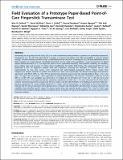Field Evaluation of a Prototype Paper-Based Point-of-Care Fingerstick Transaminase Test
Author(s)
Pollock, Nira R.; McGray, Sarah; Colby, Donn J.; Noubary, Farzad; Nguyen, Huyen; Nguyen, The Anh; Khormaee, Sariah; Jain, Sidhartha; Hawkins, Kenneth; Kumar, Shailendra; Rolland, Jason P.; Beattie, Patrick D.; Chau, Nguyen V.; Quang, Vo M.; Barfield, Cori; Tietje, Kathy; Steele, Matt; Weigl, Bernhard H.; ... Show more Show less
DownloadPollock-2013-Field Evaluation of.pdf (1.268Mb)
PUBLISHER_CC
Publisher with Creative Commons License
Creative Commons Attribution
Terms of use
Metadata
Show full item recordAbstract
Monitoring for drug-induced liver injury (DILI) via serial transaminase measurements in patients on potentially hepatotoxic medications (e.g., for HIV and tuberculosis) is routine in resource-rich nations, but often unavailable in resource-limited settings. Towards enabling universal access to affordable point-of-care (POC) screening for DILI, we have performed the first field evaluation of a paper-based, microfluidic fingerstick test for rapid, semi-quantitative, visual measurement of blood alanine aminotransferase (ALT). Our objectives were to assess operational feasibility, inter-operator variability, lot variability, device failure rate, and accuracy, to inform device modification for further field testing. The paper-based ALT test was performed at POC on fingerstick samples from 600 outpatients receiving HIV treatment in Vietnam. Results, read independently by two clinic nurses, were compared with gold-standard automated (Roche Cobas) results from venipuncture samples obtained in parallel. Two device lots were used sequentially. We demonstrated high inter-operator agreement, with 96.3% (95% C.I., 94.3–97.7%) agreement in placing visual results into clinically-defined “bins” (<3x, 3–5x, and >5x upper limit of normal), >90% agreement in validity determination, and intraclass correlation coefficient of 0.89 (95% C.I., 0.87–0.91). Lot variability was observed in % invalids due to hemolysis (21.1% for Lot 1, 1.6% for Lot 2) and correlated with lots of incorporated plasma separation membranes. Invalid rates <1% were observed for all other device controls. Overall bin placement accuracy for the two readers was 84% (84.3%/83.6%). Our findings of extremely high inter-operator agreement for visual reading–obtained in a target clinical environment, as performed by local practitioners–indicate that the device operation and reading process is feasible and reproducible. Bin placement accuracy and lot-to-lot variability data identified specific targets for device optimization and material quality control. This is the first field study performed with a patterned paper-based microfluidic device and opens the door to development of similar assays for other important analytes.
Date issued
2013-09Department
Whitaker College of Health Sciences and Technology; Harvard University--MIT Division of Health Sciences and TechnologyJournal
PLoS ONE
Publisher
Public Library of Science
Citation
Pollock, Nira R., Sarah McGray, Donn J. Colby, Farzad Noubary, Huyen Nguyen, The Anh Nguyen, Sariah Khormaee, et al. “Field Evaluation of a Prototype Paper-Based Point-of-Care Fingerstick Transaminase Test.” Edited by Pal Bela Szecsi. PLoS ONE 8, no. 9 (September 30, 2013): e75616.
Version: Final published version
ISSN
1932-6203